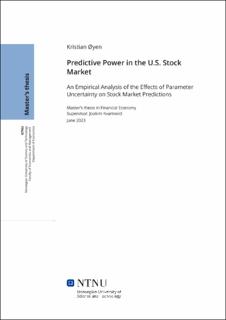| dc.contributor.advisor | Kvamvold, Joakim | |
| dc.contributor.author | Øyen, Kristian | |
| dc.date.accessioned | 2023-07-20T17:19:57Z | |
| dc.date.available | 2023-07-20T17:19:57Z | |
| dc.date.issued | 2023 | |
| dc.identifier | no.ntnu:inspera:145362779:37099397 | |
| dc.identifier.uri | https://hdl.handle.net/11250/3080567 | |
| dc.description.abstract | Denne studien analyserer prediksjonsevnen til markedsvariabler på totalavkastning i S&P 500 Composite-indeksen og dens underindekser: Dividend Aristocrats, Growth, og Value. Verdsettelsesforhold og makrofaktorer for markedet totalt sett undersøkes som prediktorvariabler på totalavkastningen for hver indeks. Resultatene viser at utbytteavkastning og Shillers CAPE-forhold har betydelig prediktiv kraft på totalavkastning, i tråd med Dividend Discount Model. Den generelle prediksjonskraften er lav, noe som indikerer begrensninger i tråd med teorien. I motsetning til hypoteser har ikke verdsettelsesforhold en sterkere prediktorkoeffisient for utbytteselskaper, slik som Dividend Aristocrats-indeksen, enn vekstselskaper eller markedet totalt sett. Rentespredning viser betydelig prediktiv kraft for Value-indeksen, og utfordrer tidligere forskning. Ikke-stasjonæritet i verdsettelsesforhold introduserer skjevhet og påvirker prognosenøyaktigheten. Disse funnene fremhever utfordringene med å forutsi indeksavkastning. | |
| dc.description.abstract | This study analyzes the predictive ability of market variables on total returns in the S&P 500 Composite index and its sub-indices: Dividend Aristocrats, Growth, and Value. Valuation ratios and macro-factors for the market overall are examined as predictor variables on total returns for each index. The results show that dividend yield and Shiller's CAPE-ratio have significant predictive power on total returns, aligned with the Dividend Discount Model. The overall predictive power is low, indicating limitations in line with theory. Contrary to expectations, valuation ratios do not have a stronger predictor-coefficient for dividend companies, such as the Dividend Aristocrats index, than growth companies or the market overall. The Term Spread shows significant predictive power for the Value index, challenging previous research expectations. Non-stationarity in valuation ratios introduces bias and affects forecasting accuracy. These findings highlight the challenges in predicting index returns. | |
| dc.language | eng | |
| dc.publisher | NTNU | |
| dc.title | Predictive Power in the U.S. Stock Market | |
| dc.type | Master thesis | |
